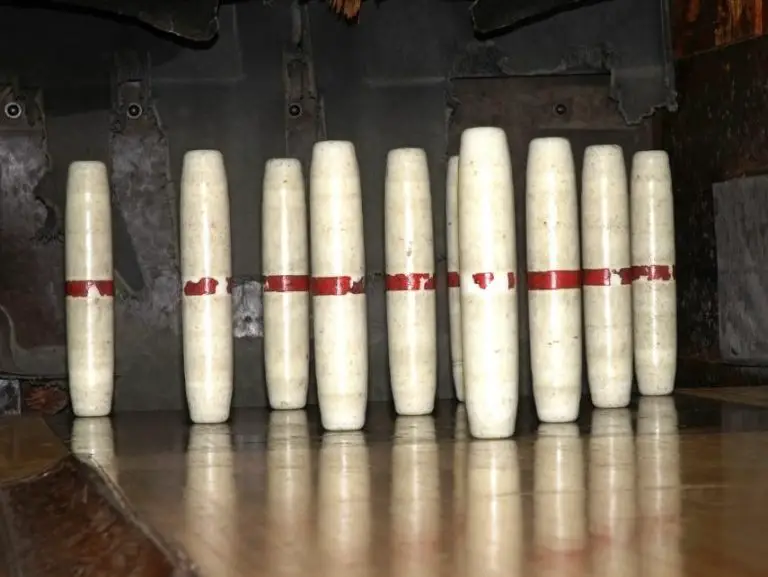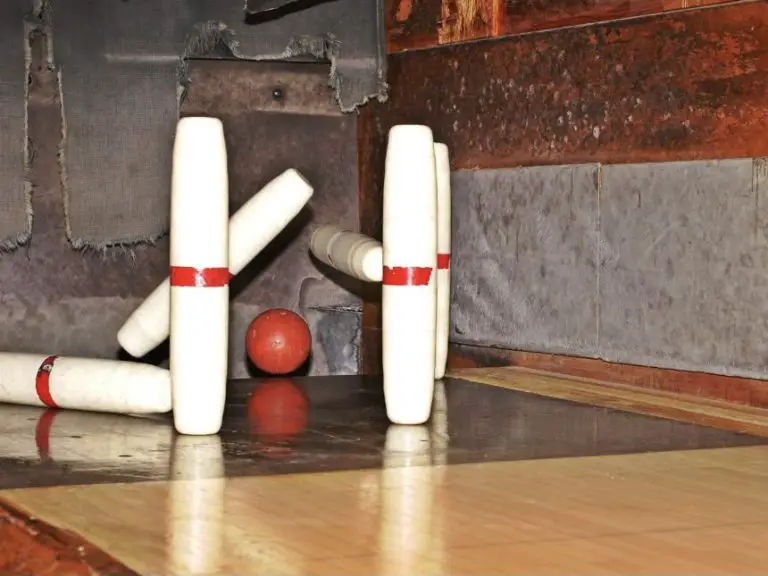What is the Highest Score in Candlepin Bowling: The Record Books
Candlepin bowling, a variation of the sport distinct from ten-pin bowling, requires precision and skill. Originated in Massachusetts in the late 19th century, it retains a dedicated following in New England and the Canadian Maritime provinces. The highest single-string (game) score ever recorded is 245 out of a possible 300 (in 1984 and 2011.)
The unique size of the ball, the shape and lightweight nature of the pins make candlepin bowling more difficult than 10-pin. Many, many 300 games have been achieved in 10-pin bowling. The candlepin record books are still waiting.
Key Takeaways
- Candlepin bowling offers a distinct set of challenges requiring precision and strategy.
- The record highest score in candlepin bowling is 245.
- Knowledge of the game’s fundamentals, such as scoring and pin positioning, enhances playing experience.
Candlepin Bowling Fundamentals
Understanding candlepin bowling fundamentals will enhance your knowledge of the game, helping you appreciate its unique characteristics. You’ll learn about the specialized equipment, gameplay mechanics, scoring intricacies, and the specific rules that distinguish it from other bowling variations.
Equipment and Lane Specifications
Candlepin bowling involves slender pins, taller and lighter than those in ten-pin bowling, and a small ball without finger holes. The candlepin bowling ball weighs 2 pounds 7 ounces maximum and has a diameter of 4.5 inches, allowing it to be held in the palm of your hand. Pins weigh almost the same.
The close ratio of ball weight to pin weight makes candlepin more difficult. 10-pin balls can weigh up to 16 pounds, while standard bowling pins weigh around 3.5 lbs. The relative force on impact is much greater in 10-pin bowling, creating a more chaotic flurry of pin movement with more potential to knock down other pins.
Lanes are similar in length to ten-pin, at 60 feet from the foul line to the head pin, and about 43 inches in width, but lack the heavy oil patterns found in other bowling types.
Gameplay Overview
During a game of candlepin bowling, you deliver the ball aiming for the, striving for accuracy and consistency. Each game has ten frames (also called boxes), and in each frame, you have up to three attempts to knock down all ten pins. An open frame occurs when some pins remain standing after all attempts.
Scoring System and Techniques
Your cumulative total is the sum of downed pins across all frames. A strike, when all ten pins are knocked down with the first ball, scores ten plus the count of pins downed in the next two balls.
A spare is when all pins are knocked down with the first two balls, scoring ten plus the count of pins downed in the next ball. Each pin down counts as one point, emphasizing the need for precise aiming techniques.
| Outcome | First Ball | Second Ball | Third Ball | Frame Score |
|---|---|---|---|---|
| Strike | 10 + | Next 2 ball | Counts | (10 + following 2 balls) |
| Spare | – | 10 + | Next ball | (10 + following ball) |
| Open Frame | – | – | – | Sum of downed pins |
In other words, candlepin is scored exactly like 10-pin bowling.
Rules and Regulations
You must roll the ball from behind the foul line and not step over it. If the ball goes into the gutter, no pins will be scored for that ball. Fallen pins are left in the lane and can be used to your advantage to knock down standing pins. The rules emphasize skill in controlling the lightweight ball and using the wood on the lane to maximize the number of downed pins.
Historical Context of Candlepin Bowling
Candlepin bowling emerged in Worcester, Massachusetts during the late 19th century. It is differentiated from traditional ten-pin bowling by utilizing slender pins and smaller, handheld balls without finger holes. The game’s creation is credited to Justin White, an owner of a bowling alley in Worcester, in 1880. The sport quickly became popular among locals, spreading throughout the New England region, including Peabody, Massachusetts, which is often considered the birthplace of organized candlepin competition.
Professional Leagues and Growth
The first professional candlepin league was established in 1901, indicative of the sport’s rapid growth in the early 20th century. By forming the National Duckpin and Candlepin Congress in 1932, candlepin bowling acquired formal governance. This body later became the International Candlepin Bowling Association (ICBA), which still oversees the sport today.
Candlepin lanes spread across New England, cementing the sport within regional culture. Recognition of excellence within the game culminated with the establishment of a Candlepin Bowling Hall of Fame, further solidifying its professional standing and honoring those who have excelled in the league.
Candlepin Bowling Records
Candlepin bowling presents unique challenges and records that differ significantly from other forms of bowling. The highest score ever recorded in a single string of candlepin bowling is 245 out of a possible 300.
Notable Achievements and Players
Ralph Semb is known for his role in promoting candlepin bowling and its popularity. Chris Sargent and Mark Ricci are amongst the professional players who made a mark in the candlepin bowling scene. Chris Sargent, in particular, tied the world record for the single string with a score of 245 in 2011.
In tournaments, achieving a score above 200 is quite rare and signifies elite performance. These professional players often compete in leagues and tournaments, where records and high scores are meticulously tracked to recognize outstanding achievements.
Comparison with Other Bowling Games
Candlepin bowling stands out due to its unique scoring rules and equipment, which makes it more challenging than traditional bowling games like ten-pin bowling.
- Ten-pin bowling: Uses larger balls and pins, and the highest possible score is 300, achieved by rolling 12 strikes in a row.
- Duckpin bowling: Similar to candlepin but with slightly larger pins, and the balls have no finger holes. The highest recorded score is 279.
- Traditional bowling (Ten-pin): Most popular and widely recognized, with professionals achieving perfect scores more frequently due to larger balls and pins.
Candlepin’s difficulty is due to the ball’s size and the pins’ shape, making strikes less common than in ten-pin or duckpin bowling. Although it may not be as widely played as ten-pin bowling, candlepin bowling has a dedicated following, particularly in Canada and the New England region of the United States.
Playing Candlepin Bowling Today
Candlepin bowling lives on as sport due to its unique charm and challenges, offering a distinctive experience compared to other forms of bowling. With advancements in technology and a committed community, candlepin bowling continues to entice both new players and seasoned professionals.
Modern Equipment and Facilities
Candlepin bowling alleys today are outfitted with state-of-the-art technology. Ball returns and automatic pinsetters have evolved, using materials such as rubber and plastic for better durability and performance. Lanes composed of synthetic materials contribute to a consistent playing surface, essential for refined gameplay.
Candlepin Bowling Strategy and Tips
To become proficient in candlepin bowling, focus on developing a consistent aiming strategy and grip. Candlepin balls, being smaller and lacking finger holes, require a different technique:
- Aiming: Aim for the “pocket” between pins to maximize the chance of a strike.
- Grip: A firm yet comfortable grip ensures better control of the ball.
- Spares Strategy: When aiming for spares, consider the angles and how pins may react, especially since pins (referred to as deadwood) remain on the lane and can be utilized strategically.
Candlepin Bowling as a Contemporary Sport
In recent years, candlepin has retained its popularity, particularly in New England, USA, where it originated. The sport is governed by the International Candlepin Bowling Association, which ensures standardized rules. Competitions range from casual league play to professional tournaments, with a few players nearing the elusive perfect game.
Candlepin Bowling Community and Events
The sense of community in candlepin bowling is vibrant. Regular leagues offer a sense of camaraderie, and special events can include tournaments or charity events. The community celebrates excellence through the Candlepin Bowling Hall of Fame, which honors players who have achieved remarkable scores and made significant contributions to the sport.
Improving Your Score
Attaining a high score requires practice and attention to details such as:
- Equipment: Use balls that fit well in your hand for better control.
- Gameplay Techniques: Focus on converting spares, and learn how to effectively handle deadwood to your advantage.
- Learning from the Best: Watch how experienced players manage the game, noting their strategies for different situations.
By embracing these aspects, you can increase your chances of achieving a score that reflects your true potential in this challenging and rewarding sport.



